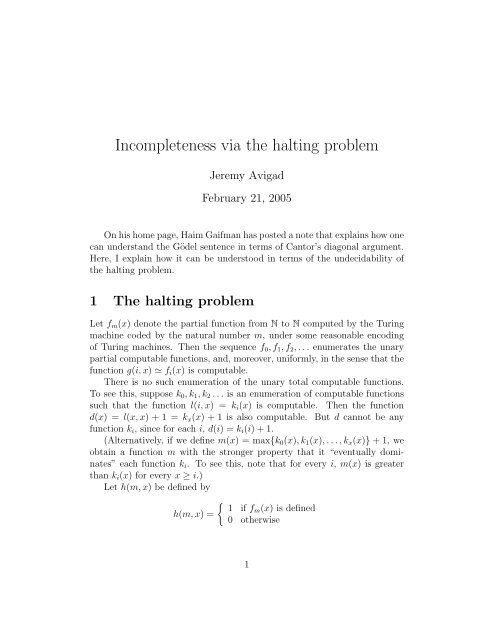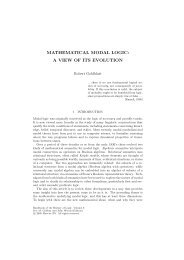Incompleteness via the halting problem
Incompleteness via the halting problem
Incompleteness via the halting problem
You also want an ePaper? Increase the reach of your titles
YUMPU automatically turns print PDFs into web optimized ePapers that Google loves.
<strong>Incompleteness</strong> <strong>via</strong> <strong>the</strong> <strong>halting</strong> <strong>problem</strong>Jeremy AvigadFebruary 21, 2005On his home page, Haim Gaifman has posted a note that explains how onecan understand <strong>the</strong> Gödel sentence in terms of Cantor’s diagonal argument.Here, I explain how it can be understood in terms of <strong>the</strong> undecidability of<strong>the</strong> <strong>halting</strong> <strong>problem</strong>.1 The <strong>halting</strong> <strong>problem</strong>Let f m (x) denote <strong>the</strong> partial function from N to N computed by <strong>the</strong> Turingmachine coded by <strong>the</strong> natural number m, under some reasonable encodingof Turing machines. Then <strong>the</strong> sequence f 0 , f 1 , f 2 , . . . enumerates <strong>the</strong> unarypartial computable functions, and, moreover, uniformly, in <strong>the</strong> sense that <strong>the</strong>function g(i, x) ≃ f i (x) is computable.There is no such enumeration of <strong>the</strong> unary total computable functions.To see this, suppose k 0 , k 1 , k 2 . . . is an enumeration of computable functionssuch that <strong>the</strong> function l(i, x) = k i (x) is computable. Then <strong>the</strong> functiond(x) = l(x, x) + 1 = k x (x) + 1 is also computable. But d cannot be anyfunction k i , since for each i, d(i) = k i (i) + 1.(Alternatively, if we define m(x) = max{k 0 (x), k 1 (x), . . . , k x (x)} + 1, weobtain a function m with <strong>the</strong> stronger property that it “eventually dominates”each function k i . To see this, note that for every i, m(x) is greaterthan k i (x) for every x ≥ i.)Let h(m, x) be defined by{ 1 if fm (x) is definedh(m, x) =0 o<strong>the</strong>rwise1
The function h(m, x) is a version of <strong>the</strong> “<strong>halting</strong> <strong>problem</strong>,” since it amountsto a decision, for each m and x, as to whe<strong>the</strong>r Turing machine m halts oninput x.The simple diagonalization above gives us an indirect way of seeing that<strong>the</strong> <strong>halting</strong> <strong>problem</strong> is unsolvable, i.e. that h is not computable. For, if hwere computable, we could compute{fm (x) if h(m, x) = 1l(m, x) =0 o<strong>the</strong>rwiseDefining k i (x) = l(i, x) would <strong>the</strong>n yield an enumeration of all <strong>the</strong> totalcomputable functions, and we have showed that this is impossible.One can prove that h is not computable more directly. Suppose h werecomputable. Then we could define a a partial function s(x) by{ 0 if h(x, x) = 1s(x) ≃undefined o<strong>the</strong>rwiseBy our hypo<strong>the</strong>sis, s(x) is a partial computable function. Let m be suchthat s = f m . Then s(m) is defined, by definition, if and only if h(m, m) = 0;but by <strong>the</strong> definition of h, this happens if and only if f m (m), i.e. s(m), isundefined.2 Provably total computable functionsIn <strong>the</strong>se notes, we will be interested in effectively axiomatized <strong>the</strong>ories of“interpret a reasonable amount of arithmetic.” In particular, if a consistent<strong>the</strong>ory T interprets Robinson’s <strong>the</strong>ory Q, <strong>the</strong>n it can represent <strong>the</strong> notions is a <strong>halting</strong> computation sequence for Turing machine m startingwith input xin such a way that for every m, x, and s, s really is a <strong>halting</strong> computationsequence for machine m on input x if and only if T proves that this is <strong>the</strong>case.Such a <strong>the</strong>ory T is said to be Π 2 -sound if <strong>the</strong> following holds:For every m, T proves “for every x, machine m halts on input x”if and only if for every x, machine m halts on input x.2
A computable function f from <strong>the</strong> natural numbers to <strong>the</strong> natural numbers issaid to be provably total in a <strong>the</strong>ory T if <strong>the</strong>re is some machine, m, computingf such that T proves “for every x, machine m halts on input x.” Saying thatT is Π 2 -sound simply amounts to <strong>the</strong> assertion that whenever T proves astatement of this form, <strong>the</strong>n machine m really computes a total function.There is a natural way of enumerating all <strong>the</strong> provably total computablefunctions of such a <strong>the</strong>ory: for each i, if i describes a proof of <strong>the</strong> statement“for every x, machine m halts on input x” for some i, let k i be <strong>the</strong> functioncomputed by machine m; o<strong>the</strong>rwise, let k i be <strong>the</strong> constant zero function.Assuming T is effectively axiomatized, this enumeration is uniform, in<strong>the</strong> sense that for every i and x we can compute l(i, x) = k i (x). But we knowfrom <strong>the</strong> preceeding section that <strong>the</strong> sequence k 0 , k 1 , k 2 , . . . cannot enumerateall <strong>the</strong> computable functions. This means that <strong>the</strong>re must be a computablefunction s that is not on <strong>the</strong> list. If m is any Turing machine that computess, <strong>the</strong>n m halts on every input, but T does not prove that m halts on everyinput. Thus we have shown that <strong>the</strong>re is a true sentence that cannot beproved in T .In fact, Gödel’s notion of ω-consistency implies Π 2 -soundness. For <strong>the</strong>Turing machine m described in <strong>the</strong> preceding paragraph, it also implies thatT does not prove (falsely) that m doesn’t halt on some input, since for eachparticular input, T can verify that machine m really does halt. Thus we haveshown:Theorem 2.1 Let T be an ω-consistent, effectively axiomatized <strong>the</strong>ory interpretingQ. Then <strong>the</strong>re is a sentence ϕ that is nei<strong>the</strong>r provable nor refutablein T .This is a weak version of first incompleteness <strong>the</strong>orem.It is instructive to spell out <strong>the</strong> argument in greater detail. For each i, letk i be <strong>the</strong> ith provably total computable function in T . Let s(x) = k x (x) + 1.We have argued that:1. s(x) is a total computable function (since T is effectively axiomatized,and Π 2 -sound), but2. T doesn’t prove s(x) is total (by <strong>the</strong> diagonal argument).Why is it that we can prove that s(x) is total, but T can’t? The answer isthat we have made central use of <strong>the</strong> fact that T is Π 2 -sound. With slightlystronger assumptions on <strong>the</strong> amount of arithmetic one can develop in T , thisargument can formalized. Thus, we have shown:3
Theorem 2.2 Let T be as above, and assume T interprets a sufficient amountof arithmetic. Then T does not prove its Π 2 -soundness.This is a weak version of <strong>the</strong> second incompleteness <strong>the</strong>orem.3 The incompleteness <strong>the</strong>oremsWe can obtain better versions of <strong>the</strong> incompleteness <strong>the</strong>orems using <strong>the</strong> moredirect proof of <strong>the</strong> unsolvability of <strong>the</strong> <strong>halting</strong> <strong>problem</strong> described in Section 1.Given an effectively axiomatized <strong>the</strong>ory T , consider <strong>the</strong> following attempt tosolve <strong>the</strong> <strong>halting</strong> <strong>problem</strong>: on input m and x, simultaneously do <strong>the</strong> following:1. simulate Turing machine m on input x, to see if it halts; and2. search for a proof in T that m doesn’t halt on input x.In <strong>the</strong> first case, output 1 (“yes”), and in <strong>the</strong> second case, output 0 (“no”).Clearly any “yes” answer is a correct answer to <strong>the</strong> <strong>halting</strong> <strong>problem</strong>.Assuming T is consistent, every “no” answer has to be correct as well. Butwe know that <strong>the</strong> <strong>halting</strong> <strong>problem</strong> is unsolvable, which means that somethinghas to go wrong. The only thing that can possibly go wrong is that <strong>the</strong>remay be a Turing machine m and an input x, such that m does not halt oninput x, but T does not prove this fact. The unsolvability of <strong>the</strong> <strong>halting</strong><strong>problem</strong> implies that this is, indeed, <strong>the</strong> case.On <strong>the</strong> o<strong>the</strong>r hand, assuming T is ω-consistent, for m and x as above, Tcannot prove (falsely) that m does halt on input x, since for each particulars it can verify that s is not a <strong>halting</strong> computation sequence. Letting ϕ be <strong>the</strong>sentence “machine m does not halt on input x,” we have shown <strong>the</strong> following:Theorem 3.1 Let T be an effectively axiomatized <strong>the</strong>ory interpreting Q.Then <strong>the</strong>re is an assertion ϕ such that if T is consistent, it does not proveϕ, and if T is ω-consistent, it does not prove ¬ϕ.This is essentially Gödel’s version of <strong>the</strong> first incompleteness <strong>the</strong>orem. It isstronger than Theorem 2.1 since for one part of <strong>the</strong> independence we onlyneed to assume <strong>the</strong> consistency of T .Again, it is instructive to unwrap <strong>the</strong> argument and make it more direct.For each x, let ψ(x) be <strong>the</strong> assertion that Turing machine x does not halt oninput x. Let m be a Turing machine that, on input x, searches for a proofof ψ(x) in T , and halts if it finds one.4
Assuming T is consistent, it does not prove ψ(m), that is, <strong>the</strong> assertionthat machine m does not halt on input m. For, if <strong>the</strong>re is such a proof, <strong>the</strong>nmachine m does halt on input m, and this fact is also provable in T , makingT inconsistent.Assuming T is ω-consistent, it does not prove ¬ψ(m), that is, <strong>the</strong> assertionthat m does halt on input m. For, we have just shown that m does not halton input m, and T can <strong>the</strong>refore verify, for each s, that s is not a <strong>halting</strong>computation sequence.The statement ψ(m), that is, <strong>the</strong> assertion that m does not halt on inputm, is a version of <strong>the</strong> Gödel sentence. The original Gödel sentence asserted “Iam not provable”; this one asserts that “<strong>the</strong> algorithm searching for a proofof me doesn’t halt.” The only difference is that <strong>the</strong> first is cast in terms ofproofs, and <strong>the</strong> second is cast in terms of algorithms. Both arguments relyon <strong>the</strong> relationship between provability and computability.Note that we have described a Turing machine m such that1. m does not halt on input m, but2. assuming T is consistent, T does not prove that m does not halt oninput m.With appropriate restrictions on T , T can carry out <strong>the</strong>se arguments. Sinceit can also show that <strong>the</strong> conlusion of T implies 1, we have:Theorem 3.2 Assuming T is consistent, effectively axiomatized, and interpretsa sufficient amount of arithmetic, T does not prove its own consistency.This is <strong>the</strong> second incompleteness <strong>the</strong>orem.One can tell a similar story to explain Rosser’s streng<strong>the</strong>ning of <strong>the</strong> firstincompleteness <strong>the</strong>orem, which lifts <strong>the</strong> assumption of ω-consistency.5
















